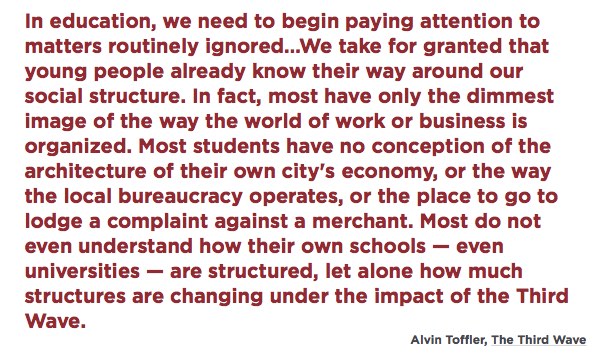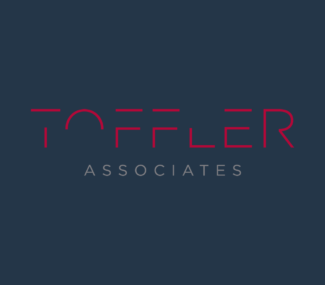What is the Right Education for the Emerging Global Workforce?

Standardized educational models in the United States have always reflected our current society and its workforce needs. So why is the majority of our school-aged demographic still engaged in a Second Wave style institution if we now live in a more global, fluid world?
In the early days of our country, the educational model consisted of a one-room schoolhouse that focused on teaching basic skills and ensuring students were done in time to help their families work in the fields and at home. In the 1800’s, the educational model evolved slightly to meet the needs of the Industrial Age. And since then, little has changed. This factory model of education, complete with bells that ring to indicate “shift” change, is still the predominant model for our public education system.
 While there have been minor modifications to this construct, we have reached the point at which we need to change our educational model drastically to meet the needs of our future workforce. That will mean exchanging the ‘formalized,’ structured education for a model wherein people actually work in their area as they learn. This is a more empirical learning model that is more seamless, flexible, and able to prepare our future workforce to think – rather than just do.
While there have been minor modifications to this construct, we have reached the point at which we need to change our educational model drastically to meet the needs of our future workforce. That will mean exchanging the ‘formalized,’ structured education for a model wherein people actually work in their area as they learn. This is a more empirical learning model that is more seamless, flexible, and able to prepare our future workforce to think – rather than just do.
Considering an Appropriate Educational Model for the Future
The process of evolving our education model begins with examining where current approaches are making gains and where they are falling short. Because enrollment in elementary and secondary public schools is approximately three times higher than its private counterparts (14.8 million in public schools versus 5.0 million students in private schools as of Fall 2014 enrollment)[1], it makes sense to begin by looking at a couple of newer, standout models that are predominant in the public school environments.
STEAM
One of the latest models – Science, Technology, Engineering, Arts, and Mathematics (STEAM) – seems to be a start in the right direction. STEAM is an integrated approach that pulls technology-focused content into our traditional core curriculum. In so doing, it elevates the awareness and intellectual use of these new core capabilities even among our youngest learners. But it remains to be seen whether the topics right for what we need our future workforce to know.
Is there a risk that innovation is happening so fast that a STEAM curriculum will be incapable of the content agility and fluidity it needs to keep up (or better yet, stay proactive)?
BYOD
The bring your own device (BYOD) model may be a better picture of the direction we need to take. This model provides a hands-on, experiential use of technology for learning (e.g., digital textbooks, submitting work via online dropboxes, and online chat platforms). BYOD digitizes the traditional education model and in so doing, takes learning farther outside the classroom. This application recognizes that our youngest learners are native technology users and that Third Wave innovations (i.e., Internet, mobile, cloud) are core to how they gather and disseminate knowledge, communicate, share, test ideas, and accomplish goals. These are steps that define the innovation process.
By teaching our kids through this kind of seamless, ‘boundary-less’ learning and communicating model, we may be preparing them to function in the Third Wave and beyond. But does the BYOD model go far enough to answer the intellectual questions of a future workforce?
Privatized Models
Since the beginning of formalized education in this country, we have been reliant on our state and federal governments to establish educational standards and practices. It’s worthwhile asking whether this reliance is the best way to encourage innovative ideas. What can we learn from private industry and what role can companies at the forefront of innovation play in education? What can we learn from privatized education models that already exist?
We don’t have to look far to examine some of the more innovative models that are relatively well entrenched in communities across the US.
- The Big Picture School model focuses on breaking down the barriers between education and the workforce by allowing students to focus on and explore their interests.[2]
- The Alt School allows students to become involved in goal setting and shuns the standardized testing approach that schools have followed for decades.[3]
Both of these models have a history (albeit short) of real, measurable success with what is now considered ‘alternative’ educational models – but which may prove to be more appropriate to the needs of our students as those young individuals become members of the workforce.
Because they are such new concepts, how long will it take to understand the long-term economic and social benefits or detriments of these highly fluid, experiential models? Can we afford the risk?
Educating for the Third Wave
Regardless of the path that we choose, we have to understand that education in the United States is giant steps behind the progress of the Third Wave. As long as we continue to operate in an Industrial Age educational model, we will be doing our society a disservice. The workforce we need urgently is filled with science-literate citizens and skilled, knowledgeable engineers, innovators, and critical thinkers able – and confident – in their ability to meet the needs of our nation and the global economy.
This is not a task for a small group of intellectual elites. This requires a collective conversation that engages members of the private and the public sectors, educators, innovators, and others. The members around this table should reflect the diverse current and future states of our global society. With this approach, we may be able to enact the necessary fundamental changes to how we think about education so we can affect positive change on industry, our economy, and our role as responsible global citizens.
It’s time to rethink how we are preparing our youngest members of the future workforce for success in the global arena.
{{cta(‘befa9ff3-80a5-4a6c-b483-9daadb37b099’)}}
[1] U.S. Department of Education, National Center for Education Statistics. (2016). Digest of Education Statistics, 2014 (NCES 2016-006), Chapter 1.
[2] http://www.bigpicture.org
[3] https://www.altschool.com
- Categories
- Workforce of the Future


 About the Authors
About the Authors